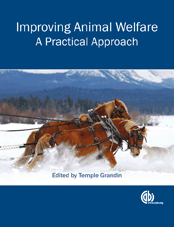 |
Improving Animal Welfare: A Practical ApproachEdited by Dr. Temple GrandinColorado State University, USA
ISBN: 978-1-84593-541-2
Subject Classifcation: KNAC, PSVP, TVH, TW
Links for ordering: |
 |
Improving Animal Welfare: A Practical ApproachEdited by Dr. Temple GrandinColorado State University, USA
ISBN: 978-1-84593-541-2
Subject Classifcation: KNAC, PSVP, TVH, TW
Links for ordering: |
This chapter covers the importance of using numerical scoring of animal based outcome measures. For example, there are huge differences between the best dairy farms and the worst dairy farms on the percentage of lame dairy cows and on the percentage of cattle with swollen hocks. This chapter contains photos and diagrams for scoring, leg conformation, and leg lesions on dairy cows and pigs.
Below is an excerpt from Chapter 1...
The author observed a big increase in lame slaughter weight pigs between 1995 and 2008. A major breeder of lean rapidly growing pigs did nothing about it in the USA until in some herds 50% of the slaughter weight pigs were clinically lame. They also had very poor leg conformation. This breeder was selecting for leanness, loin-eye size and rapid growth, and over a 10-year period they did not notice that there were more and more lame pigs. The increase in lameness was mainly genetic because the pigs were all housed on the same concrete slats that had been used for years. A recent US study indicated that 21% of the sows were lame (VanSickle, 2008). A study of sows in Minnesota indicated that risk of removal from the breeding herd increased when leg conformation was poor. Culling of breeding sows that was attributable to poor legs was 16.37%for the fore-limbs and 12.90% for the back legs Tiranti and Morrison, 2006). A study done in Spain showed that poor leg conformation was associated with higher sow culling rates (deSeville et al., 2008). Selecting breeding gilts with structurally correct feet and legs will provide better welfare and productivity.
| Percentage of cows on | |||||
|---|---|---|---|---|---|
| Well-being issue | Best 20% of farms | Second best 20% of farms | Middle 20% of farms | Second worst 20% of farms | Worst 20% of farms |
| Hock hair loss only | 0-10 | 10.6-20 | 20.8-35.6 | 36.2-54.4 | 56-96.1 |
| Hock swelling | 0 | 0.7-1.7 | 1.9-4.2 | 4.2-11.9 | 7.4-12.5 |
| Severe swellinga | 0 | 0 | 0 | 0-1.5 | 1.8-10.7 |
| Dirty cowsb | 0-5 | 5.3-9.8 | 10.3-15.4 | 16.8-28.9 | 29.4-100 |
| Thigh lesions | 0 | 0 | 0 | 0 | 0-28.8 |
 Click here to return to the Homepage for more information on animal behavior, welfare, and care.
Click here to return to the Homepage for more information on animal behavior, welfare, and care.